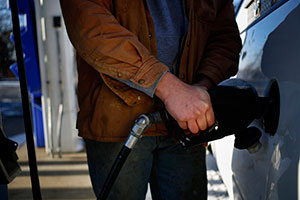Steep Drop in Gasoline Prices Diminishing, Lundberg Says

The average price of regular gasoline at U.S. pumps dropped 13.3 cents to $2.069 a gallon, as the plunge may be abating, according to Lundberg Survey Inc.
Prices are $1.242 lower than a year ago, according to the survey, which is based on information obtained at about 2,500 filling stations during the two weeks ended Jan. 23 by the Camarillo, California-based company.
Gasoline prices may be nearing a trough after falling in every Lundberg survey since July. Declines have lost steam and prices will be hitting a bottom soon unless there is a renewed plunge in crude oil prices, according to Trilby Lundberg, the president of Lundberg Survey.
“In the past 10 days, the wholesale prices that gasoline marketers and retailers pay are up,” Lundberg said in a telephone interview. “Retail prices will most likely be bottoming soon, if they haven’t already.”
The highest price for gasoline in the lower 48 states among the markets surveyed was in San Francisco, at $2.54 a gallon, Lundberg said. The lowest price was in Albuquerque, New Mexico, where customers paid an average $1.73 a gallon. Regular gasoline averaged $2.33 a gallon on Long Island, New York, and $2.42 in Los Angeles.
West Texas Intermediate crude, the U.S. benchmark priced in Cushing, Oklahoma, declined $2.77, or 5.7 percent, to $45.59 a barrel on the New York Mercantile Exchange in the two weeks to Jan. 23. Prices have fallen 58 percent since June 20.
U.S. oil output fell to 9.186 million barrels a day in the week ended Jan. 16, after reaching 9.192 million Jan. 9, the highest level in weekly Energy Information Administration data dating back to 1983. U.S. production has increased 70 percent in five years as companies have used horizontal drilling and hydraulic fracturing to tap into hydrocarbon-rich layers of underground shale rock.
Crude oil remained below $50 after Salman Bin Abdulaziz Al Saud said he would maintain Saudi Arabia’s energy policies after taking over as king following his predecessor’s death on Jan. 22. Oil has slumped about 36 percent since the Organization of Petroleum Exporting Countries’ Nov. 27 accord to maintain production at 30 million barrels a day amid a glut caused in part by the fastest U.S. output in three decades.
King Abdullah oversaw a fivefold expansion in the size of the Arab world’s biggest economy and met the Arab Spring with a mixture of force and largesse. He died after almost a decade on the throne. Saudi Oil Minister Ali Al-Naimi, who led OPEC’s November decision to defend market share against surging U.S. shale supplies, remains in his post, according to state-run Saudi Press Agency.
With production of 9.5 million barrels a day and exports of 7 million, Saudi Arabia accounts for more than 10 percent of global supply and a fifth of crude sold internationally.
Refineries processed 14.9 million barrels of oil a day in the week of Jan. 16, the lowest level since October 2013 and down 9.2 percent in just two weeks.




